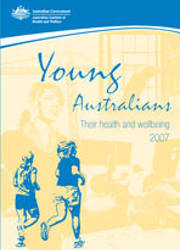Notes
Amendments
17 Jul 2007 - A number of changes have been made to correct data and reflect editorial comments.
- Page ix - Associate Professor Judy Cashmore University of Sydney.
- Page 30 - The ABS 2004–05 National Health Survey estimated that 835,310 injury events occurred among young people in the 4 weeks preceding the survey. The most frequently reported injury that resulted in a health action being taken was being cut with a knife, tool or other implement (34%), followed by hitting something or being hit by something (20%) and a low fall (20%). Males and females reported similar frequencies of each of these injury events.
- Of those young people who reported an injury, 10% had days off work or study and 23% had to cut down on usual activities due to the injury event.
- Note - Amendments have been made to page 30 to correct the figures relating to the number of injury events occurring among young people.
- Page 37 - The prevalence of short-sightedness (or myopia) was similar to that found by Ip et al. (2006) in their recent study of 12-year-old Australian school children (12%). An amendment has been made to correct the figure relating to the prevalence of myopia found by Ip et al. (2006).
- Page 89 - The majority of students (93%) surveyed in the 2002 National Survey of Secondary Students and Sexual Heath reported that they were sexually attracted to the opposite sex only.
- Page 109 - Figure 3.16: Victims of alcohol- and drug-related incidents in the past 12 months, aged 14–24 years, by incident and sex, 2004 2 of 2. An amendment has been made to correct the caption to Figure 3.16.
- In the 12 months prior to the survey, 31% of young people aged 14–24 years were the victim of drug-related violence (including alcohol-related violence) . Verbal abuse was the most common form of drug-related violence experienced by young people (27%), followed by being ‘put in fear’ (15%), and physical abuse (5%).
- Page 118 - Turrell et al. (2006) examined data from the 1989-90, 1995 and 2001 ABS National Health Surveys and found that people with lower educational attainment (no postschool qualification or a diploma/vocational qualification) rated their own health more poorly, and reported a number of illnesses more often than those with a bachelor degree or higher.
- Page 119 - Source: ABS 2002d, 2007b. An amendment has been made to correct the source of Figure 3.22.
- Page 124 - Source: ABS 2006j. An amendment has been made to correct the source of Figure 3.24.
- Page 126 - The national apparent retention rate to Year 12 in 1980 was 35% but in 2006 this rate rose to 75% (ABS 2007b). Amendments have been made to correct the figures relating to the national apparent retention rate to Year 12 in 1980 and 2006.



